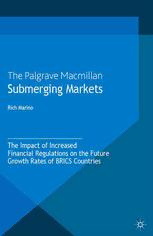
Submerging Markets: The Impact of Increased Financial Regulations on the Future Growth Rates of BRICS Countries PDF
Preview Submerging Markets: The Impact of Increased Financial Regulations on the Future Growth Rates of BRICS Countries
Submerging Markets This page intentionally left blank Submerging Markets The Impact of Increased Financial Regulations on the Future Growth Rates of BRICS Countries Rich Marino © Rich Marino 2013 All rights reserved. No reproduction, copy or transmission of this publication may be made without written permission. No portion of this publication may be reproduced, copied or transmitted save with written permission or in accordance with the provisions of the Copyright, Designs and Patents Act 1988, or under the terms of any licence permitting limited copying issued by the Copyright Licensing Agency, Saffron House, 6–10 Kirby Street, London EC1N 8TS. Any person who does any unauthorized act in relation to this publication may be liable to criminal prosecution and civil claims for damages. The author has asserted his right to be identified as the author of this work in accordance with the Copyright, Designs and Patents Act 1988. First published 2013 by PALGRAVE MACMILLAN Palgrave Macmillan in the UK is an imprint of Macmillan Publishers Limited, registered in England, company number 785998, of Houndmills, Basingstoke, Hampshire RG21 6XS. Palgrave Macmillan in the US is a division of St Martin’s Press LLC, 175 Fifth Avenue, New York, NY 10010. Palgrave Macmillan is the global academic imprint of the above companies and has companies and representatives throughout the world. Palgrave® and Macmillan® are registered trademarks in the United States, the United Kingdom, Europe and other countries ISBN 978-1-349-34862-6 ISBN 978-1-137-29650-4 (eBook) DOI 10.1057/9781137296504 This book is printed on paper suitable for recycling and made from fully managed and sustained forest sources. Logging, pulping and manufacturing processes are expected to conform to the environmental regulations of the country of origin. A catalogue record for this book is available from the British Library. A catalog record for this book is available from the Library of Congress. 10 9 8 7 6 5 4 3 2 1 22 21 20 19 18 17 16 15 14 13 This book is dedicated to the memory of Dr S. R. ‘Larry’ Epstein, Professor of Economic History at the London School of Economics. In the very short time that I had the privilege of knowing him, he was my professor and my graduate super- visor, but more importantly he taught me that even an old dog like me can learn new tricks. This page intentionally left blank Contents List of Figures viii List of Tables ix Acknowledgments xi Part I The Need for Increased Regulation 1 I ntroduction 3 2 Overview of Regulations: Historical and Current 18 Part II Capital Flows and Growth Rates Revisited 3 C apital Flows from the 1990s to the Current Dayy 33 4 G DP Growth Rates for Advanced Economies and Selected Emerging Markets including the BRICS 51 Part III The BRICS: Capital Flows Analyses 5 A n Analysis of Brazil’s Economy Relative to Its Capital Flows 71 6 A n Analysis of Russia’s Economy Relative to Its Capital Flows 86 7 A n Analysis of India’s Economy Relative to Its Capital Flows 102 8 A n Analysis of China’s Economy Relative to Its Capital Flows 118 9 An Analysis of South Africa’s Economy Relative to Its Capital Flows 134 Conclusions 10 C onclusion 151 Notes 180 Index 193 vii List of Figures 1.1 The inconsistent trinity 12 3.1 Net financial flows to emerging and developing countries 35 3.2 Composition of financial flows 36 3.3 Common factors underlying the variation of net capital flows 38 3.4 Net private capital inflows to emerging markets 41 3.5 Commodity boom spurs capital flows 49 5.1 Credit to Brazilian households y/y percentage 74 5.2 Brazil’s fiscal accounts as a percentage of GDP 83 5.3 Brazil’s inflation rate forecast y/y percentage 84 5.4 Brazilian labor market unemployment rate y/y 85 6.1 CPI inflation Russia 2011 92 6.2 Energy trajectory 95 6.3 World Bank peak oil prices 97 7.1 India’s balance of payments (nine components) 104 7.2 India’s GDP growth by specific sectors, 2007–12 111 8.1 The evolution of China’s pattern of growth – what do investment patterns suggest? 129 8.2 China’s inflation rate 130 9.1 G DP growth by specific sectors, 2007–11 137 9.2 G ross domestic expenditures as a percentage of GDP, South Africa, by component, 2007–11, Q1 139 viii List of Tables 3.1 Emerging market economies in Europe: capital flows 45 3.2 Asian emerging market economies: capital flows 4 6 3.3 Latin America: capital flows 48 3.4 Africa and Middle East: capital flows 49 4.1 The global outlook in summary 52 4.2 The global outlook, 2009–13 53 4.3 I nternational capital flows to developing countries rebound surpassing 2008 levels 58 6.1 Net capital flows, 2006–11 87 6.2 Russia’s GDP growth rate by main sectors, 2006–10 8 8 6.3 Labor, productivity, disposable income, wages and unemployment, 2008–11 89 6.4 Regional unemployment in Russia, 2009–11 90 6.5 Inflation in Russia (CPI 2011) 92 6.6 Amendment to 2011 federal budget 94 6.7 Outlook for Russia, 2011–12 94 6.8 World Bank average oil price range 96 6.9 Russia’s economic growth 99 7.1 Condensed balance of payments 105 7.2 India’s GDP growth rate by specific sectors 111 7.3 Current account balance as percentage of GDP 115 8.1 Sources of foreign exchange build-up 121 8.2 China: main economic indicators 123 8.3 China’s trade volumes exports and imports 124 8.4 Prices and exchange rates 126 8.5 The global environment 127 8.6 China’s headline government spending 132 9.1 P redicted changes in savings rates in South Africa (percentage points) 136 9.2 S outh Africa’s GDP growth rate by specific sectors, 2007–11 (annual percentage) 138 9.3 Macroeconomic indicators (percentage rates) 1 42 9.4 Public finances (percentage of GDP) 143 9.5 Current account (percentage of GDP) 144 ix
